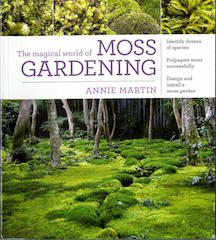The Magical World of Moss Gardening
Last Updated on November 21, 2022 by

by Annie Martin
ISBN 978-1-60469-647-9
Timber Press. Portland, Oregon, 2015
Welcome to the little-known world of gardening with mosses. In this publication, gardener Annie Martin introduces you to moss gardening and offers exciting ideas for your garden landscape. Annie Martin’s enthusiasm for moss conservation centers on salvaging moss colonies in sites slated for demolition and using them for educational projects or for her nursery/landscaping business. As she lacks formal training, the author is not a bryologist; instead she calls herself a “mosser,” someone who “practices any moss activity.” Since her passion and profession revolve around mosses, this seems appropriate. In the book, she uses the terms bryophyte and moss interchangeably, but in most cases, she refers only to mosses, excluding liverworts and hornworts. The author’s experience appears to be limited to the region around the Blue Ridge Mountains in North Carolina; this is her first book.
The front cover of the book proclaims, “Identify dozens of species.” Yes, two dozen (plus one) moss species are described, but only ten of these occur in or are abundant enough in the Pacific Northwest to consider for gardening. The book is 8 x 9 inches, printed on quality paper, and in full color with approximately 240 photos, drawings, and charts. However, the text does not refer to these illustrations and they appear to be inserted at random. The reference section is minimal and the entire book is in small font. Bryophyte terms, such as acrocarp or pleurocarp, are always followed by a definition; a short glossary would have alleviated this redundancy. The book assumes its audience has a basic knowledge in bryology and gardening.
The colorful photos will energize your desire to start your own moss garden. The photos include many design ideas that could be applied to any garden, whether featuring vascular or non-vascular plants. In contrast to the dramatic photos, the text is simplistic and somewhat boring, bouncing erratically from technical to nontechnical terms, with an overall effect of dulling the excitement of the images.
Mosses are available for purchase from the author (she lists her business e-address); however, she fails to discuss conservation in any context other than rescuing mosses from construction projects and logging sites. She doesn’t caution against the collection of State-listed rare or uncommon bryophyte species, or collecting species from special habitats; nor does she warn readers of the dangers of introducing exotic moss species or spreading invasive, non-native moss species.
If you are looking for a book of design ideas for gardening, the photos in this publication are outstanding and will pique your interest. If you have a good understanding of gardening and are looking for a book with detailed moss gardening designs and techniques or propagation methods tailored to Oregon, this publication is too general.
—Ron Exeter, Botanist, Bryologist, Lichenologist, Mycologist, Master Gardener; Salem, Oregon.
